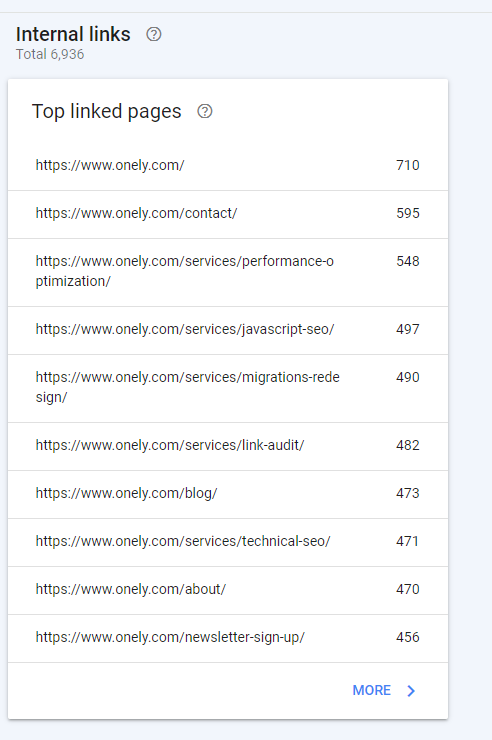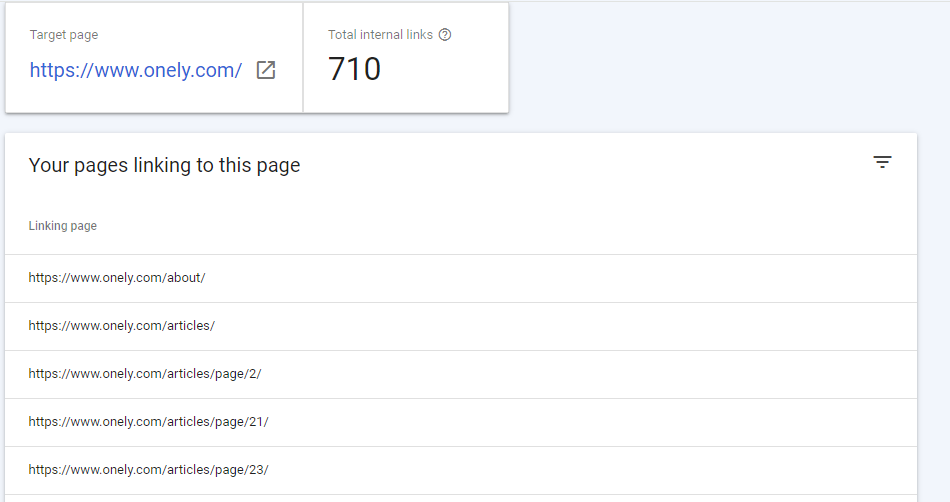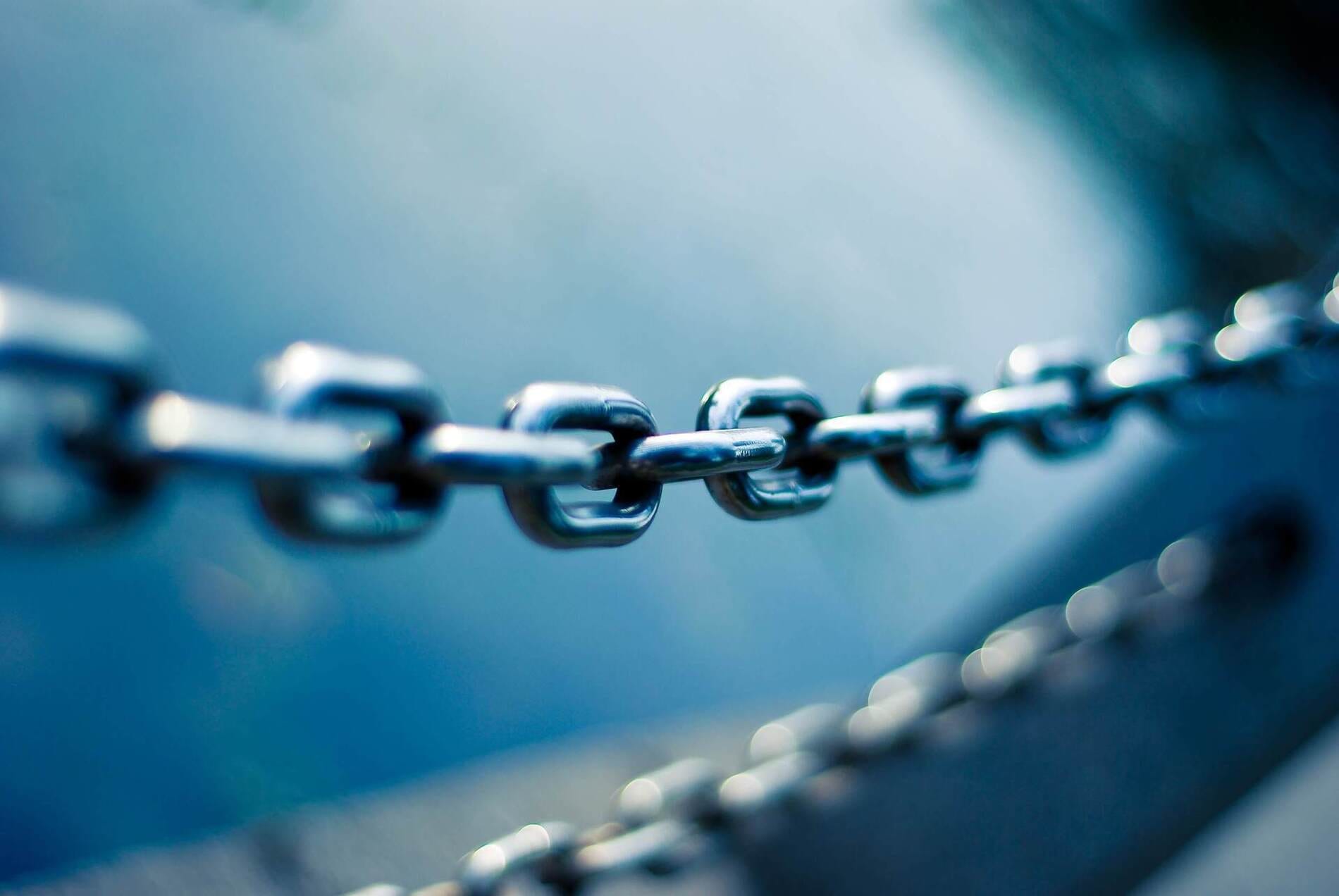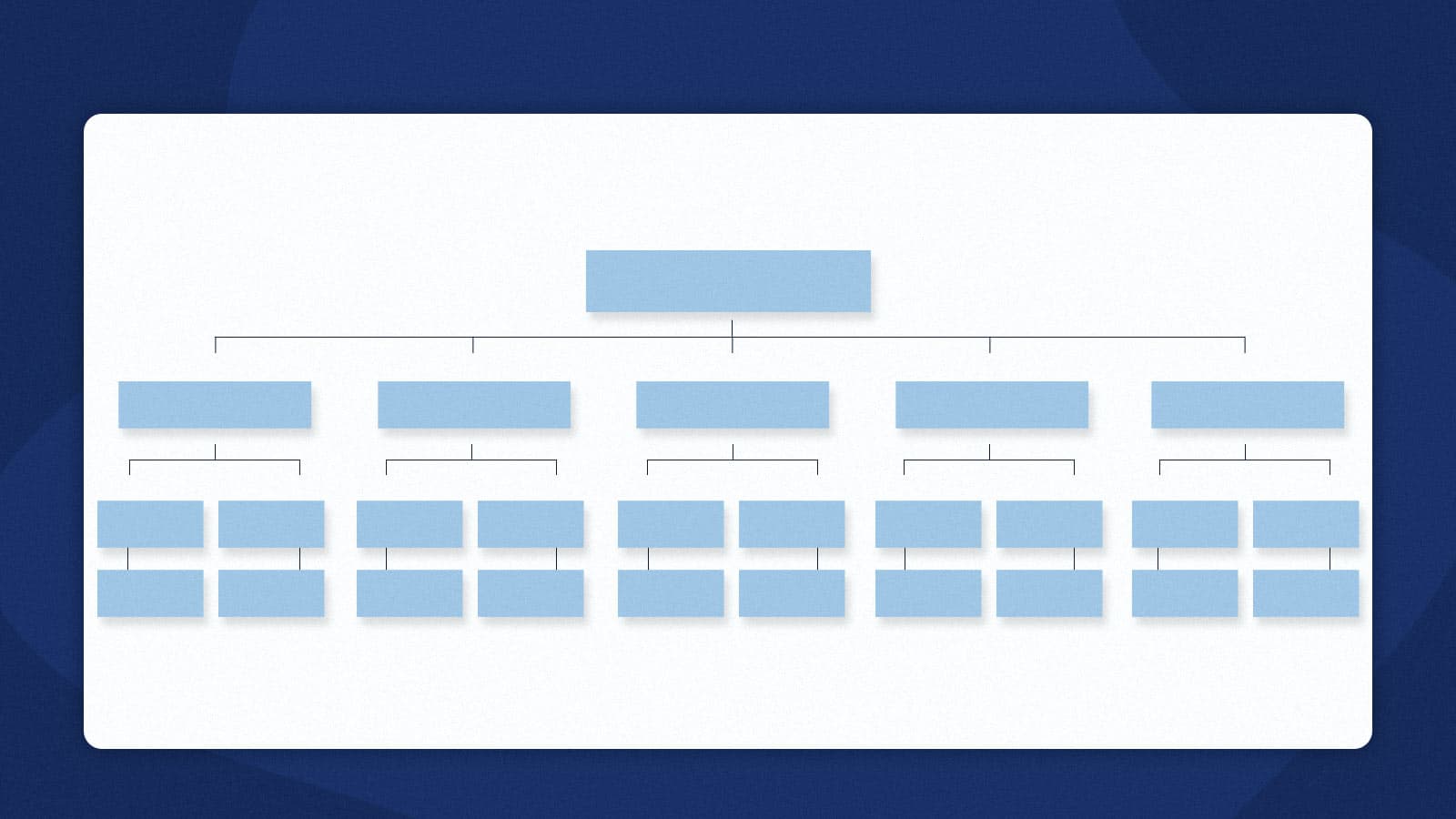Internal links are hyperlinks that point to pages on the same domain. They provide users and search engines with additional information on how your pages relate to each other, and they can potentially improve your search rankings.
SEOs tend to focus on acquiring backlinks (links from other domains), forgetting how powerful internal linking is, especially that it’s something much more within their control.
Internal links are the core of SEO – search engines use them to discover and understand web pages. But, to fully benefit from internal linking, you need to have an internal linking strategy that’s closely aligned with how your audience browses your website and why they visit respective pages.
Your internal linking strategy can have a visible impact on your business objectives.
With optimized internal linking, your key pages have more potential to drive traffic to your site. Moreover, pages on your site can provide a user-first experience by enabling visitors to swiftly navigate your site and reach pages, products, and articles that satisfy their search intent.
This article explains the importance and use cases of internal linking in SEO and describes the principal aspects of internal linking that should be the focal points of your SEO strategy.
How is internal linking used in SEO
Internal linking has pivotal importance for search engine optimization.
It conveys context, shows the relationships between pages, shares authority between them, helps users (including search engines) find what they are looking for, and guides them towards important content – the list goes on and on.
Here is precisely how internal links impact SEO:
Crawling and indexing pages
Search engine crawlers follow internal and external links on pages to discover and crawl new content.
By optimizing the way your pages are linked together, you help search engines find all of your content. This information is crucial for your pages to be crawled and further indexed.
Neglecting your internal linking structure can have severe negative consequences for your search visibility. If any of your pages don’t have internal links, backlinks, or aren’t included in the sitemap, Google likely won’t find and crawl them.
Each of your newly published pages, especially ones that should be indexed and drive traffic to your pages, will benefit from having internal links from other pages on your site.
Understanding context
Internal links need to be contextually relevant and valuable for visitors to give them a helping hand while browsing a website.
The more accurate your internal linking, the more it can direct search engines through your site architecture, show what its topic and context are, and how it relates to other pages within the site’s hierarchy.
An important part of internal linking optimization is making sure your internal links connect pages that are semantically close to each other, and that labels on your links (anchor text) appropriately explain those connections.
Highlighting the importance of pages
By frequently linking to a page, especially from other valuable pages on your website, you can indicate to search engine crawlers that the given page is vital for your site.
That’s why it’s a good call to focus on linking to your most valuable pages as part of your internal linking strategy.
If a page has a lot of internal links coming to it, Google could be more inclined to crawl and index it.
PageRank
The crucial way that internal links influence SEO is by helping PageRank (link equity) flow through a website.
PageRank is Google’s original algorithm that assigns a score of importance to a page. It can be passed from one page to another, meaning a site can build its PageRank score by being linked to from another site with a high PageRank score.
Though PageRank isn’t used in Google’s algorithms today like it was in the early days of the search engine, link equity transferred between pages is still valuable and influences search rankings.
PageRank can be calculated both for a set of pages on one website and for a larger set of websites and their pages.
So on the one hand, internal links determine the internal PageRank score for pages on your website. For instance, it’s common that the homepage on any given website has the greatest PageRank score because it’s linked to from all other pages on that website.
On the other hand, internal links also determine how the PageRank value received from external links is distributed on your website. For example, if one of your blog posts gets many internal links from external sources, using internal links can spread PageRank from that blog post to other posts on your website that you want to boost in search results.
For the sake of transferring PageRank to your pages, it’s recommended you link from your most authoritative pages (the top of which will usually be the homepage) to other pages on your domain to help them rank higher.
Keep in mind that link equity gets diluted, so the further the page is from the link, the less authority it will be granted. The link authority of the homepage will be shared between all links on it, then passed to those on the linked to pages, and so on.
Consolidating signals
Google doesn’t always respect the canonical tags you use on your pages and can determine that another page would be more suitable for getting indexed if the canonical tag is the only signal indicating the page’s importance. It gets more probable if you’re sending mixed signals to Google — for example, when one page version has the canonical tags pointing to it, but there are internal links on your domain that are pointing to other versions of that page.
By adding relevant internal links with keyword-rich anchor text to the canonical page, you provide additional signals to enhance the chances of your canonical page being seen as the primary version by search engines.
Best practices for internal linking
Above all, your internal linking strategy should be user- and Google-friendly.
And here are the actions that will help you achieve it.
Connecting your content pieces
Internal links are the building blocks of your site structure that are simultaneously tightly aligned with the content on your site. Thus internal links need to be incorporated into your content strategy.
You should consider how different content pieces can be connected via internal linking.
The fundamental aspect of your content and internal linking strategy should be understanding:
- Who your audience is,
- What your audience’s pain points are,
- What user journeys they take within your site,
- Where and how they convert.
Make sure you understand what terms your users are searching for and the intent behind them. If you know your audience well, you will know where to place internal links and what anchor text to use to answer questions that your audience may ask next.
At the same time, you need to know what user problems each of your pages is solving and how to best serve these solutions, such as which concepts may require more explanations and should include links to further reading.
Creating topic clusters
One way to write content that can be cleverly connected is by creating topic clusters – pieces of content collectively covering general topics.
Each cluster will consist of:
- A pillar page with an overview of a broader topic, and
- Several supporting cluster pages, typically linked to from sections or subchapters of the pillar page, each of which discusses a more detailed topic related to the main topic. Cluster pages usually also link back to the pillar page and other pillar pages.
Topic clusters provide an abundance of SEO benefits:
- Users get easy access to related content on your page,
- Search engine crawlers gain insight into the context of your content, the topics you thrive in, and the structure of your site,
- Topic clusters highlight numerous opportunities for including relevant and descriptive anchor text in your links,
- Creating topic clusters helps demonstrate expertise and breadth of coverage on a topic to Google and users, who can then view you as an authority.
Other solutions for internal linking and content
There are many other solutions for incorporating strategic internal linking into your main content, depending on your niche and type of content.
These solutions include:
- Creating sections with related articles, linking to thematically-connected content or pieces useful for further reading,
- Adding sections with related products, either displaying alternatives or additional options users may want to purchase to complement the currently viewed product,
- Adding links to topic pages to collect all thematic pieces of content in one place – you can read Barry Adams’ post about internal links to topic hubs based on news sites,
- Creating author pages containing all pieces of content written by a specific author.
Writing informative anchor text
Anchor text is the visible text in a hyperlink.
Search engines use it to understand what the linked page may be about. You can use this to your advantage by providing both regular users and crawlers with informative anchor text that accurately describes the content of the linked page. This may help the page in question rank better by giving search engines an additional source of semantic information.
When adding links, always think about their context and include anchor text that makes it easy for users and search engines to determine what the target page will contain and what topic it’s related to.
Most links do provide a bit of additional context through their anchor text. At least they should, right‽
— John Mueller (official) · #MaybeABot (@JohnMu) November 23, 2017
This can be achieved by including relevant keywords, including any variations that make sense.
Just as it is with writing regular content, anchor text shouldn’t be excessively filled with keywords. Make sure keywords appear in your anchor text in a natural way. The content of the linked to pages and their anchor text should align contextually and not mislead users or search engines.
Google advises against using generic anchor text, like “here,” “learn more,” or “link.” If you use it, you may have the exact anchor text for different links – you should avoid it as it confuses search engines and the context they get about your page.
Other practices to avoid include using long paragraphs as anchor text and using the page’s URL as an anchor.
If your internal links are navigational, the anchor text needs to clearly describe the contents of the page that users and search engines are about to visit.
Optimizing click depth
Click depth is the number of clicks it takes from the homepage to reach another page on the same website.
For instance, if you have an eCommerce website and to reach a given product from the homepage you first need to navigate to a category page, then a subcategory page, then click on a link to the product, its click depth is 3 — it took three clicks to get there.
There are various recommendations for how many clicks are optimal – though the age-old three-click rule has long been disproven. As usual, there is no universal number.
John Mueller discussed click depth in a 2018 episode of Google SEO Office Hours:
You should aim to limit the distance of your most profit-driving pages from the homepage. The closer a page is to your homepage, the greater the transfer of link equity to that page.
This is because Google may perceive pages buried deep within the structure as unimportant. Google has a limited crawl budget for each site – so it could ultimately skip crawling pages on your site that are deep inside your structure, or recrawl them less frequently.
You should also think of users – how long will it take them to reach your key content? Can they easily access it? What is the experience like for them?
This is something that even your clients or colleagues can help you with. Ask them about their impressions of navigating the site and consider their feedback in implementing changes to the site.
Breadcrumbs are an assortment of internal links, typically found at the top or bottom of a page, providing a “breadcrumb trail” depicting the site’s structure. From the standpoint of Information Architecture, breadcrumbs are an element of local navigation — they help you understand where in the overall website structure you currently are.
Visitors can use breadcrumbs to navigate back to a previous section in the site structure.
Breadcrumbs tend to first include the root page as the most general page, leading to more specific sections next.
Here is an example of a breadcrumb trail:
Home > Category > Article (Your current location on the website)
Aside from improving user experience, breadcrumbs show a clear path to search engines on how your content is organized and help them discover essential sections of your website.
Finally, breadcrumbs pass along valuable link equity.
Breadcrumbs aren’t mandatory for every website. They may not be necessary if you have a smaller website with a simple structure.
But it’s probably a good idea to add breadcrumbs if you have a large eCommerce site or a marketplace site.
Suppose you decide that breadcrumbs will be suitable for your site. In that case, you can add breadcrumb structured data to improve the chances of your breadcrumb navigation being indexed correctly and appearing in search results with an enhancement:

Linking to orphan pages
Orphan pages have no internal links coming to them.
This should generally be avoided because, if a page has been orphaned:
- Google may have a hard time finding, crawling, and indexing such pages (note that orphan pages could still get indexed if they have backlinks, are included in the sitemap, or have canonical tags pointing to them),
- PageRank won’t flow to such pages through internal links,
- Users may struggle to locate your page.
But not every page on your site needs heavy internal linking – for instance, you don’t have to focus too much on linking to pages that shouldn’t be indexed or are less profitable for your business.
Optimize placement of links
Consider where your internal links are placed on the page – they can be located in various places – in a menu, header, footer, content body, etc.
John Mueller talked about the importance of the links’ location on the SEO Office Hours:
It’s slightly different when it comes to text in there in that we try to understand what the primary content is of the page. And when it comes to ranking relative to the other content on your website, we’ll try to focus on the primary content section of the page. But links, from our point of view, just help us to better understand a site’s structure. And whether they’re in the header, or in the footer, or the sidebar, or the main content, that doesn’t really change anything for us.
John’s words could suggest that links located in the main content on a page are more important than links in any supporting content. But, regardless of whether placing links higher on the page impacts rankings or not, they will be more visible to users, who will be more likely to click on them, hence visiting more pages on your site and improving dwell time, giving you a higher chance of getting more visitors to convert.
You should primarily focus on internal links in your site’s main navigation and footer.
The main site navigation should have links to the most important categories and sections of the site.
From a user’s perspective, including links to important pages in your main navigation helps them quickly find the content they need. Such important pages could be your blog, shop, top categories, or subcategories – predominantly transactional links.
Meanwhile, your footer should contain informational links, such as About, Privacy policy, or Disclaimer, unless you think that users need to be able to access them from the main navigation.
Decide on the number of internal links
Google’s current recommendation for the number of links to include on a page is to: “Limit the number of links on a page to a reasonable number (a few thousand at most).”
Having too many links on a page can actually hurt your site:
It’s like this one giant mass of pages for this website, and they’re all interlinked, we can’t figure out which one is the most important one. We can’t figure out which one of these are related to each other. And in a case like that, having all of those internal links, that’s not really doing your site that much. […] If you do dilute the value of your site structure by having so many internal links that we don’t see a structure anymore, then that does make it harder for us to understand what you think is important on your website.
Don’t focus on trying to include as many links as possible. Instead, concentrate on adding links where they make sense and provide value.
It is also expected that, at times, you will have the same internal link on one page more than once. It won’t cause issues, but Google may focus on the anchor text for the link that appears first on the page.
As a side note: if your article mentions the same phrase (relating to a topic, person, place, etc.) more than once, you don’t need to link to it every time it appears. In this case, it’s suggested you link to it only once, at the first mention.
Technical considerations of internal linking
Some internal linking best practices consider technical implementations.
To crawl them, search engine bots need to be able to access them.
First of all, if possible, internal links shouldn’t be loaded onto a page with JavaScript – the preferred option is a standard HTML format of a link.
Also, read how important it is not to block your internal resources when using JavaScript in our guide on JavaScript SEO.
Links also shouldn’t require a bot’s interaction. For example, search engine bots won’t see links:
- accessible after submitting a form,
- Loaded after a click or scroll event,
- accessible through internal search boxes, or
- pointing to pages blocked by robots.txt directives or the meta robots tag.
Learn everything you need to know about robots.txt!
Read the ultimate guide to robots.txt for SEO on our blog.
If Google sees a lot of links to duplicate, spammy or thin content or is unable to load some of it, it may stop crawling or rendering other content on the site, assuming it’s not worth spending its resources on.
You should also monitor broken links responding with 4xx status codes – they can lead to wasted crawl budget and impaired user experience.
To address the issue, fix the broken page within the same URL or implement a redirect to another relevant URL. Broken links are a sign of poor quality for search engines, and they may damage your users’ browsing experience.
Learn more about 4xx client error statuses in Google Search Console by reading our articles on: “Blocked due to other 4xx issue.”
Another issue you can’t ignore is internal links to redirected pages with 3xx status codes. In many cases, it will be a good call to remove the additional, unnecessary link hops. Nonetheless, it could be unavoidable to keep them, particularly if the site has undergone a website migration and the pages have moved.
But, even in such cases, don’t forget about your anchor text. If you redirect pages to a new URL but forget to update the original anchor text, those links could send mixed signals to Google about the new destination page.
Auditing internal linking structures
You should regularly monitor your internal links, their status, anchor text, and whether they make sense for your site. These checks are included in every technical SEO audit that we conduct.
There are some practical tools for auditing your internal linking, one of which is the Links report in Google Search Console.
Concerning internal links, it gives you a quick overview of the most linked pages on your site:

And which pages are linking to them:

You can turn to other SEO tools for a more detailed analysis of your internal linking structure.
For example, Ahrefs’ Site Audit tool lets you discover technical issues with internal links, such as broken links, links to redirected pages, and orphan pages. (You can also use the list of detected URLs with redirects available in your Google Search Console in the “Page with redirect” status.)
You can also use it to display all your working internal links to analyze their click depth and whether they are all relevant.
Ahrefs also has a feature called Link Opportunities, showing where you should add links to benefit from them the most in search.
Semrush offers an Internal Linking report within the Site audit section. It will give you the following information:
- Crawl depth of pages,
- The number of pages being linked to and ones linking to others, as well as orphan pages,
- Internal linking issues – divided into errors, notices, and warnings,
- Internal link distribution,
- Pages passing the most PageRank.
If you’re a fan of old-school and creative solutions, you can read our article on how to plan link building with Scrapebox and use this controversial tool for White Hat SEO purposes.
Wrapping up
If users struggle to find the content they came to your site for, they might decide to leave. And, if search engine crawlers can’t access your essential, indexable pages, they may not get indexed and won’t rank for relevant keywords.
You can successfully mitigate these risks with a well-executed internal linking strategy.
Internal linking helps pass link authority between your pages and shows the context of your content so it can rank strategically for desired topics.
The only magic formula for internal linking is common sense and understanding how search engines and users explore your site.

Hi! I’m Bartosz, founder and Head of SEO @ Onely. Thank you for trusting us with your valuable time and I hope that you found the answers to your questions in this blogpost.
In case you are still wondering how to exactly move forward with fixing your website Technical SEO – check out our services page and schedule a free discovery call where we will do all the heavylifting for you.
Hope to talk to you soon!








